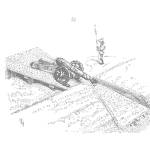
Making Changes and Assumptions
Abstract
James and Fred discussing the frustration that one can experience when defaults change.
ᐅ Play Episode
Your Reliability Engineering Professional Development Site
Author of Maintenance and Reliability articles, ebooks, and host of Rooted in Reliability, co-host on Speaking of Reliability.
This author's archive lists contributions of articles and episodes.
by James Kovacevic Leave a Comment

James and Fred discussing the frustration that one can experience when defaults change.
ᐅ Play Episode
by James Kovacevic Leave a Comment

It turns out that you have been deploying the right reliability tools and maintenance practices, but the organization’s culture was preventing or hampering the results. This is a common scene played out in many organizations, but there is hope. The culture change will be a long road, as cultures are not changed overnight. [Read more…]
by James Kovacevic Leave a Comment

When you are installing a new machinery in a facility of the organization, there are certain issues. These issues are listed from top to the bottom categorized on the basis of seriousness. The top of the list is shaft alignment. It is the most common issue while installing the machinery. It occurs due to lack training or of precision instruments, as well as measurement misconceptions. Most organizations think they have achieved alignment just because an instrument showed so. They don’t take the stress and heating mechanisms into account which causes misalignment between the collinear wings of the shaft.
ᐅ Play Episode
by James Kovacevic Leave a Comment

Imagine working within (or maybe you don’t need to imagine it) an organization in which everything is completely reactive. You arrive early to try and organize the work for the day, yet only to find out someone else is there doing it. [Read more…]

In the maintenance and reliability industry, we have maintenance engineers, manufacturing engineers, and reliability engineers. There is a little bit difference between the types. A maintenance engineer is there to make sure the equipment is in running condition as soon as possible once a failure occurs. He has to get the asset operational the quickest possible time. He performs day to day routine checks to make sure the asset is running without defects. He does precision maintenance and promotes industry best practices. He is responsible for checking alignment, balancing, and other technical effects that might be overlooked by others.
ᐅ Play Episode
by James Kovacevic Leave a Comment

Regardless of how good a maintenance & reliability program is set up and managed, there will be failures. This is partly due to the maintenance program itself, where the focus is on the consequences of the failures, not the failures itself. This approach allows most organizations to manage large facilities will a minimum of staff and cost.
But what should happen when something does fail? Should we just carry on as usual since we avoided the consequences? Absolutely not. When a failure occurs, we need to learn from it and improve the maintenance & reliability program. Yet, many organizations address failures by implementing a PM routine. This is not the right approach. Remember only 11% of failures are age-related. Adding these PM routines to the program will cause a collapse of the program from too much work, not to mention the maintenance induced failures that result from it.
So what should happen? The failure should be analyzed and actions implemented to reduce the chance of the failure occurring again.
[Read more…]
by James Kovacevic Leave a Comment

Whenever we talk about successful business practices, planning and scheduling remains a key element. Not only it helps you track performance but it also helps you build on the initial layout later on. Through performance management, you will know what’s going on inside an activity and process. Now, performance management is the combination of systems that are responsible for achieving the goals of the organization. These may include accountability, assessment, and measurement techniques that are used in the organization. On the lower level, metrics are being used to measure performance.
ᐅ Play Episode
by James Kovacevic Leave a Comment

A failure has just occurred on a critical asset in your facility. The result was 2 hours of lost production, but it could have been worse. The last time that the equipment failure occurred it took 5 hours to repair. Why was the failure repaired in less than half the time than the previous occurrence? How can we ensure that we learn from this failure and the team’s performance to improve the plant performance?
I remember reading about a simple philosophy quite a few years ago (although I can’t remember who stated it, so I apologize that I cannot provide a reference), about a simple analysis that can be applied to any maintenance activity to improve performance. This analysis is call the 2 Up / 2 Down analysis.
The 2 Up / 2 Down analysis is quite simple and involves asking two questions.
[Read more…]
by James Kovacevic Leave a Comment

No matter how good you are at your job, there are always failures in the systems because of some reason. You can’t stop all of them but you can learn from them. There is always something to learn when a failure occurs. Whether it is finding the root cause or devising a solution to prevent it in the future. What happens in the industry that we forget what failures occurred in the last few years?—over the time. This is something that is alarming. It is your job to remember or communicate with those who might. That is how you can better assess the nature and root cause of the failure.
ᐅ Play Episode
by James Kovacevic Leave a Comment

James and Fred discussing the benefits you and your organization will realize when doing FA and RCA correctly.
ᐅ Play Episode
by James Kovacevic Leave a Comment

Many organizations try to improve performance by just creating PM routines and letting the technicians loose to perform the work. This often has negative effects on plant performance. This has been proven through studies conducted by Ledet at numerous DuPont sites. This study looked at the impact of Planning, Scheduling and Preventative Maintenance on Plant Performance.
Ledet had found that by just implementing a PM / PdM program, organizations lost 2.40% of uptime (on a baseline of 83.50%). Not quite the results to expect when implementing a strategy to improve plant performance. When the PM / PdM program is implemented with Planning & Scheduling, the plant saw an increase of 5.10%. Now that is an improvement.
But what about the remaining 11.40% of uptime? How does one address the remaining downtime?
[Read more…]
by James Kovacevic Leave a Comment

The main goal of every organization is to get the quality product in the market. That’s why they spend millions of dollars to stay on the plan they had in place. They can’t do that if their equipment keeps failing. The only way to make it sure is to maintain it properly. And that is a job for reliability engineers. They are the ones who maintain the assets of the company. They find the cause of the failures and stop it by making the system design better. They play a role similar to the process engineer but their job has a wider scope.
ᐅ Play Episode
by James Kovacevic Leave a Comment

The organizations that are more innovative and have a mark in the industry tend to do things that others don’t. So, what are those things and how do they do that? This is an area where process engineers play their role to increase the production and solve problems that come along the way. Sometimes they have to experiment using different chemicals, use the calculations, and use the recorded data to come up with processes that can increase the yield of a product without compromising the quality. Their job is to come up with the best ways to quantify product.
ᐅ Play Episode
by James Kovacevic Leave a Comment

If there are a couple of things that pops to mind when talking about leadership is that leaders are made not born and that all leaders shared the same set of qualities that make them as such (think about John C. Maxwell’s book “The 21 Indispensable Qualities of a Leader”). These two statements seem to complement each other and reflect the general tone of today’s podcast episode.
ᐅ Play Episode
by James Kovacevic Leave a Comment

Striving to be best in class is perhaps the ultimate goal of every organization. But what exactly does it take to get there? In the first part of this podcast, we talked about the changes seen in maintenance, reliability, and failure analysis over the years and what makes these practices successful in best in class organizations.
ᐅ Play Episode
 Ask a question or send along a comment.
Please login to view and use the contact form.
Ask a question or send along a comment.
Please login to view and use the contact form.